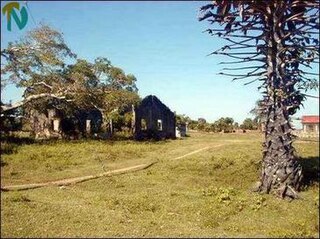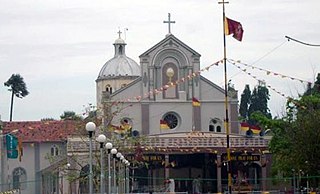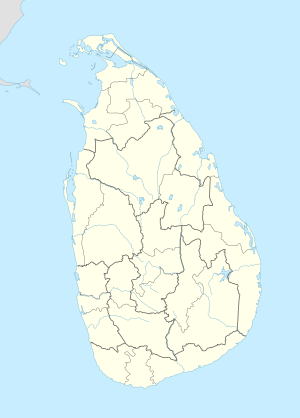
The Sri Lankan Civil War was a civil war fought in Sri Lanka from 1983 to 2009. Beginning on 23 July 1983, it was an intermittent insurgency against the government by the Velupillai Prabhakaran-led Liberation Tigers of Tamil Eelam. The LTTE fought to create an independent Tamil state called Tamil Eelam in the north-east of the island, due to the continuous discrimination and violent persecution against Sri Lankan Tamils by the Sinhalese-dominated Sri Lanka government.
Human rights in Sri Lanka provides for fundamental rights in the country. The Sri Lanka Constitution states that every person is entitled to freedom of thought, conscience and religion, including the freedom to have or to adopt a religion or belief of his choice. And, that every person is equal before the law.

The Sri Lankan state has been accused of state terrorism against the Tamil minority as well as the Sinhalese majority, during the two Marxist–Leninist insurrections. The Sri Lankan government and the Sri Lankan Armed Forces have been charged with massacres, indiscriminate shelling and bombing, extrajudicial killings, rape, torture, disappearance, arbitrary detention, forced displacement and economic blockade. According to Amnesty International, state terror was institutionalized into Sri Lanka's laws, government and society.

Kumarapuram massacre also known as 1996 Trincomalee massacre or 1996 Killiveddy massacre refers to the murder of 26 Sri Lankan Tamil civilians by the Sri Lankan Army soldiers on February 11, 1996. The victims included 13 women and 9 children below the age of 12. Further 28 civilians were severely injured as well. The event took place in a village called Kumarapuram, located in the eastern district of Trincomalee. It was a notable mass murder of civilians since the resumption of armed conflict between rebel forces and Sri Lankan armed forces since April 1995, as part of the Sri Lankan civil war. The then-government arrested a number of soldiers and home guards who allegedly carried out the massacre. A court case was started on 2004. On 27 July 2016 the court acquitted six former army Corporals who were accused over the massacre, after they were found not guilty.

The Vankalai massacre was a massacre of a family of four minority Sri Lankan Tamils at the hands of the Sri Lankan military personnel from the village of Vankalai in Mannar District, Sri Lanka on June 8, 2006. The victims were tortured and the mother was gang raped before her murder.
The Kent and Dollar Farm massacres were the first massacres of Sinhalese civilians carried out by the LTTE during the Sri Lankan Civil War. The massacres took place on 30 November 1984, in two tiny farming villages in the Mullaitivu district in north-eastern Sri Lanka. The Sri Lankan government labeled this as an attack on civilians by the LTTE.
The Palliyagodella massacre was carried out by the Liberation Tigers of Tamil Eelam (LTTE) against the mostly Muslim population of the Palliyagodella village located on border region of the northern part of Sri Lanka that were controlled by the Tigers at the time. This was the largest massacre of Muslim civilians by the LTTE to date. Village eyewitnesses claim that some 285 men, women and children, around a third of the population, were killed by a 1,000 strong force of the Tamil Tigers; however, the Sri Lankan government states that the LTTE massacred 166 to 171. All but 40 of the victims of the Palliyathidal massacre were Muslim; the rest were Sinhalese.
The 2006 Trincomalee Massacre of NGO Workers, also known as the Muttur Massacre, took place on 4 or 5 August 2006, when 17 employees of the French INGO Action Against Hunger were shot at close range in the city of Muttur, Sri Lanka, close to Trincomalee. The victims included sixteen minority Sri Lankan Tamils and one Sri Lankan Muslim.
Eelam War I is the name given to the initial phase of the armed conflict between the government of Sri Lanka and the LTTE.

The Jaffna hospital massacre occurred on October 21 and 22, 1987, during the Sri Lankan Civil War, when troops of the Indian Peace Keeping Force entered the premises of the Jaffna Teaching Hospital in Jaffna, Sri Lanka, an island nation in South Asia, and killed between 60 and 70 patients and staff. The rebel Liberation Tigers of Tamil Eelam, the government of Sri Lanka, and independent observers such as the University Teachers for Human Rights and others have called it a massacre of civilians.
The 1985 Valvettiturai massacre happened on May 12, 1985 after 2 landmine attacks killed 10 soldiers and an officer in Valvettiturai. 70 minority Sri Lankan Tamil civilians from the town of Valvettithurai, Sri Lanka were rounded up. They were asked to go inside the town library and then the library was blown up by the Sri Lankan Army killing all of them. The LTTE would later apparently retaliate in Anuradhapura. In the ensuing weeks dozens more Tamil civilians were also killed.
The 1984 Mannar massacre was the killing of 200+ minority Sri Lankan Tamils civilians by Sri Lankan Army soldiers in the town of Mannar, north-western Sri Lanka, on December 4, 1984. The attack was triggered when three Army jeeps hit a land mine, killing one soldier. In retaliation, landmarks such as the Central hospital, the post office, a Roman Catholic convent as well as villagers working in rice paddy fields and bus passengers were attacked. Villages around Mannar town such as Murunkan and Parappankadal were also attacked. Immediately after the incident, the then Sri Lankan President J. R. Jayawardene appointed a Presidential commission of inquiry. A local Roman Catholic priest, Mary Bastian who was a member Presidential commission was later killed in January 1985. A Methodist minister George Jeyarajasingham, who was a witness to the incident, was also killed in December 1984.
The war was waged for over a quarter of a century, with an estimated 70,000 killed by 2007. Immediately following the end of war, on 20 May 2009, the UN estimated a total of 80,000–100,000 deaths. However, in 2011, referring to the final phase of the war in 2009, the Report of the Secretary-General's Panel of Experts on Accountability in Sri Lanka stated, "A number of credible sources have estimated that there could have been as many as 40,000 civilian deaths." The large majority of these civilian deaths in the final phase of the war were said to have been caused by indiscriminate shelling by the Sri Lankan Armed Forces.

The 1985 Trincomalee massacres refers to a series of mass murder of Tamil civilians by the Sri Lankan military and Sinhalese home guards in Trincomalee District, Sri Lanka. In a succession of events that spanned over two months, hundreds of Tamil civilians were massacred and thousands were driven out by the Sri Lankan military and Sinhalese mobs in order to colonize the area. Almost every Tamil settlement in the district was destroyed during this well-orchestrated campaign to drive out the local Tamil population. Several Tamil women were also raped. In September 1985, the entire Tamil population of Trincomalee town was displaced to forests and refugee camps in an attack that wiped out the town, including the destruction of 12 temples and a mosque. Since August 16, over 50,000 Tamils who were forced to flee the town ended up in refugee camps in the Jaffna and Batticaloa districts.
Terrorism in Sri Lanka has been a highly destructive phenomenon during the periods of the Sri Lankan Civil War (1983–2009) and the first and second JVP insurrections. A common definition of terrorism is the systematic use or threatened use of violence to intimidate a population or government for political, religious, or ideological goals. Sri Lanka is a country that has experienced some of the worst known acts of modern terrorism, such as suicide bombings, massacres of civilians and assassination of political and social leaders, that posed a significant threat to the society, economy and development of the country. The Prevention of Terrorism Act of 1978 is the legislation, that provides the powers to law enforcement officers to deal with issues related to terrorism in Sri Lanka. It was first enacted as a temporary law in 1979 under the presidency of J. R. Jayewardene, and later made permanent in 1982.
The following lists events that happened during 1985 in Sri Lanka.

The 1987 Eastern Province massacres were a series of massacres of the Sinhalese population in the Eastern Province of Sri Lanka by Tamil mobs and Liberation Tigers of Tamil Eelam (LTTE) during the Sri Lankan Civil War. Though they began spontaneously, they became more organized, with the LTTE leading the violence. Over 200 Sinhalese were killed by mob and militant violence, and over 20,000 fled the Eastern Province. The violence has been described as having had the appearance of a pogrom.







